Some things are better together - and when it comes to fish finder/GPS combos, that’s definitely the case. Fish finder/GPS combos, sometimes called chartplotters, are more than the sum of their parts. By combining the two, you can set waypoints on the fly, chart your own maps, navigate away from treacherous waters, and more.
Here’s our list of the top fish/finder GPS combo units in 2022!
| Humminbird HELIX 10 CHIRP GPS G4N | Lowrance HDS-9 LIVE | Lowrance HOOK Reveal 7 | Garmin Striker 4 GPS Fish Finder | Garmin Striker Vivid 9sv |
|---|---|---|---|---|
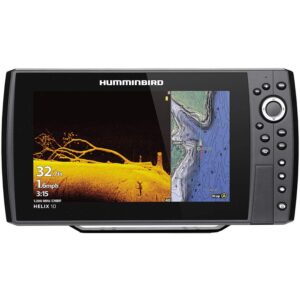 |
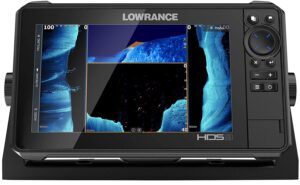 |
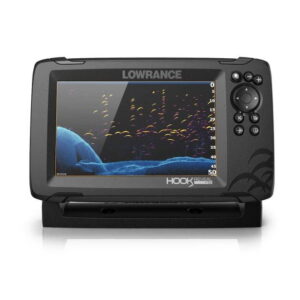 |
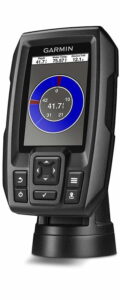 |
 |
| Frequency: 150-220 kHz 180-240 kHz, 140-200 kHz | Frequency: N/A | Frequency: CHIRP 200 kHz; DownScan/SideScan 455/800 kHz | Frequency: 2D Sonar: 200 kHz / 15° and 77 kHz / 45° | Frequency: Traditional: 50/77/200 kHz ClearVü and SideVü 260/455/800 kHz |
| Transducer: XNT 9 HW T | Transducer: N/A | Transducer: DownScan | Transducer: 77/200 kHz CHIRP | Transducer: GT52HW-TM |
| Screen: 256 colour TFT | Screen: WVGA | Screen: N/A | Screen: backlit, HVGA color | Screen: 9” display, 800 x 480 pixels, HD, backlit |
| Screen Size: 10.1" | Screen Size: 9" | Screen Size: 7" | Screen Size: 3.5 | Screen Size: N/A |
| Resolution: 1024 x 600 pixels | Resolution: 1280 x 720 pixels | Resolution: 800 x 480 SolarMax | Resolution: 480H x 320V | Resolution: N/A |
| Backlit: Yes | Backlit: Yes | Backlit: N/A | Backlit: N/A | Backlit: N/A |
| Imaging: Max 400 ft. Down; Max 400 ft. Down, Max 800 ft. Side-to-side | Imaging: 150 ft. Down/Per Side (800 kHz); 300 ft. Down/Per Side (455 kHz) | Imaging: 150 ft. - 300 ft. down; 100 ft. per side (800 kHz)/ 300 ft. per side (455 kHz) | Imaging: N/A | Imaging: ClearVu 500 ft, SideVu 500 ft (250 ft per side) |
| GPS: Internal, High-Precision | GPS: Internal, High-Precision | GPS: Internal, High-Precision | GPS: Internal, High-precision | GPS: Internal, high precision |
| Maps Included: Humminbird Basemap | Maps Included: C-MAP® US Enhanced Inland and Coastal | Maps Included: None OR 4000 US Lakes OR C-Map Contour+ | Maps Included: Not Available | Maps Included: N/A |
| Max Waypoints: 2,500 (47 routes, 50 tracks/20,000 points) | Max Waypoints: 3,000 (100 routes, 100 tracks/10,000 points) | Max Waypoints: 3000 (100 routes/100 tracks) | Max Waypoints: 5,000 | Max Waypoints: 5000, 100, 50 (50,000) |
| Memory Card Slots: 2 SD | Memory Card Slots: 2 Micro SD | Memory Card Slots: Micro SD | Memory Card Slots: N/A | Memory Card Slots: N/A |
| Transmit Power: N/A | Transmit Power: N/A | Transmit Power: N/A | Transmit Power: 200 W (RMS) | Transmit Power: N/A |
| Best Price (Amazon) Best Price (Bass Pro) | Best Price (Bass Pro) | Best Price (Amazon) Best Price (Bass Pro) Best Price (Amazon) Best Price (Bass Pro) Best Price (Amazon) Best Price (Bass Pro) | Best Price (Amazon) Best Price (Bass Pro) | Best Price (Amazon) Best Price (Bass Pro) |
The Hook Reveal 7 is a dependable fish finder for fishing hobbyists and anglers alike. It’s affordable if you’re looking for a unit that’s under $900, and it’s a massive step up from previous models. Lowrance has jam-packed this fish finder with user-friendly features, improved mapping capabilities, and a wider selection of transducers.
There are three different transducers available with this device: the SlipShot, TripleShot, and 50/200 HDI. Some buyers may be confused with their purchase if they aren’t aware of the three different options. The SplitShot is the least expensive of the three, while the TripleShot offers both SideScan and StructureMap, and the HDI offers the best range and depth. All three include CHIRP sonar which provides accurate information and endless mapping features. While its lack of networking capabilities could prove frustrating for some buyers, its price point and features are hard to resist.
An upgrade from the HDS Carbon series, Lowrance’s HDS-9 Live’s impressive diversity has made this piece of tech an angler’s dream come true. With CHIRP sonar to dual imaging capabilities, this fish finder can offer anglers the tools they need to succeed. The unit’s 3-in-1 imaging setup is an excellent choice for fishing in deep or shallow water, as it permits the conditions to be handled with nothing but absolute success.
With a beautiful HD display, waterproof features, and accessible interface, it can be hard to resist this piece of fish finder tech, even with its higher price point. If you’re new to fishing, the HDS-9 Live may be best suited for more experienced anglers looking to catch a lot of fish.
An excellent and affordable option when it comes to CHIRP imaging sonar devices. While it doesn’t have any preloaded maps, you can take advantage of the included Quickdraw Contours Mapping Software that allows you to build your own maps with one-foot resolution. In addition, you can download existing maps onto this device while using the ActiveCaptain app. Many anglers will find that the ability to record waypoints and routes on your map is a huge help when navigating the waters.
The original Striker Plus 4 does have a slightly lower resolution, but what it lacks in pixels it makes up for in a bigger display and mapping functionality. Other than that, the Strike 4 features better screen resolution.
If you’re serious about fishing, the Humminbird Helix 10 is loaded with an abundance of features that improves the fishing experience. The unit may be bulky, but it’s lightweight and provides a large display screen that no one can be mad about. Its 360 imaging helps anglers get a better view around the boat with continuous imaging updates that will tell you if a fish enters or leaves the area. Its GPS is another fine addition that helps anglers track locations correctly and connects you to the reliable Humminbird base map. You will find charts of about 10,000 lakes in the U.S., with detailed information about the underwater terrain and nearby places.
If you’re looking for a fish finder unit with dual SD card slots, dependable sonar capabilities, HD radar, and other useful features for a price point of $1700-$2000, this unit has everything you could ask for.
The Striker Vivid 9sv delivers on its crispy display and sonar capabilities which is always a must-have when catching fish. This fish finder tech is easy to use with its zoom and range adjusting features, and the addition of the app has proven useful. Connect your Vivid 9 to the mobile app, and you can find/share charts with other fellow anglers. You can also use the app to display maps of the general area, including marinas, stores, and more.
While there’s a lot to like about this piece of tech, there is still much to be desired. The unit does not come with any included maps. The only way to create maps yourself is through the Quickdraw Contours addition. The unit also has no Ethernet ports and no NMEA compatibility. The unit relies heavily on the use of your mobile phone, as it supports both Bluetooth and Wi-Fi connectivity. With these drawbacks in mind, the Vivid 9sv is on the list because of its more affordable price point, display, sonar, and app capabilities.
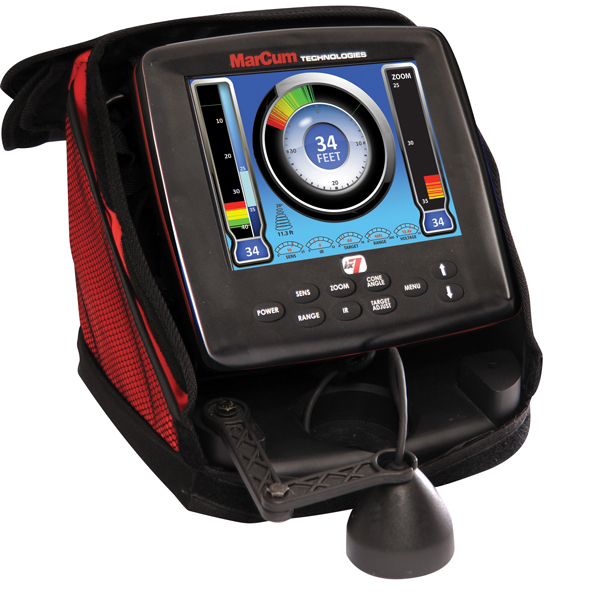
We love chartplotters, and we’ve reviewed a lot of them. We want to share what we’ve learned with you; whether you use that knowledge to gain insight into how we chose our top chartplotters or to make your own comparisons is up to you.
The main criteria we look at are the quality of the transducer and sonar, the quality of the GPS, the mapping and charting features available, the display and interface, how easy the unit is to mount, its overall durability, and its power consumption. Let’s delve deeper into each one of those features.
A few terms to cover before we get down to business:
With that out of the way, let’s talk about what we look for in a sonar system. We want a transducer/fish finder combo capable of sending out a variety of different frequencies. Lower frequencies give you more depth and range, while higher frequencies give clearer, more accurate images.
We also want CHIRP technology and imaging - let’s take a look at both of those now.
Compressed high intensity radiated pulse (CHIRP) is a technology that was swimming around in military circles for years but (somewhat) recently became available on retail fish finders.
To understand CHIRP - and why we love it - you need to know a little bit about sonar. Your transducer is transmitting and receiving frequencies. Those frequencies come back altered based on what objects they bounced off of, and your transducer uses those alterations to determine the qualities of the object the frequency touched.
While traditional sonar sends out one frequency, CHIRP sends out a pulse containing multiple frequencies. That means there’s more information coming back to the transducer - it can use the varying frequencies to make a more accurate image of what those frequencies are bouncing off of.
CHIRP is the gold standard for 2D sonar right now, and you won’t find a high-quality fish finder without it. All of our top picks for imaging feature CHIRP sonar. We predict that, soon enough, there won’t be any fish finders without CHIRP.
Down imaging shows you what’s going on below your boat in incredible clarity - it makes it easy to spot structure, baitfish, and more. We’re always fans of down imaging, but we’ve found it’s particularly good with fish finder/GPS combos.
The major reason for this is that you can set waypoints on your down imaging chart. Let’s say you’ve passed over a sunken ship that you want to come back to later - just select the ship on your down imaging chart (usually by double-tapping) and set a waypoint. You don’t even need a map open to be able to do this.
You may also find some fish finders that allow you to overlay your down imaging onto a chart - though this feature tends to be chart-dependent. While we don’t use this feature too often, some people like it, so we thought we’d mention it.
Side imaging is a lot like down imaging, but instead of seeing below your boat, you get insight into what’s going on underwater to either side of your boat!
We’re sure you could have guessed that.
Down imaging usually gives a maximum of 400 feet down, while side imaging maxes out at 400 feet per side. The advantages are pretty much the same - side imaging is a great scouting tool, and having a GPS allows you to set waypoints easily and navigate back to points of interest. We highly recommend a map and GPS if you’re going to use side imaging.
Cone angles are pretty straightforward - actually, they go straight forward and a bit to the sides, but we were speaking metaphorically. Basically, narrow cone angles (often around 12°) penetrate deeper but give less side-to-side range, while wider cone angles are best used in shallower water.
We gave points to units that come bundled with transducers offering a variety of different cone angles.
Looking at a list of the best fish finder/GPS combos, you might expect to see a lot of information about the GPS in each device. After all, you need accurate positioning for these chartplotters to be worth the money!
We’ve got good news (unless you were really hoping for an elaborate lesson on GPS) - all of these units come with internal, high-precision GPS. While we’re not going to say that all GPS devices are the same, we will say that all of the GPS devices in these fish finders are similar enough that we don’t need to discuss them further. They’ll accurately track your position - enough said.
If you were let down by the slim information on the different GPS devices available, don’t you worry - we’re getting into the meat (fish) and potatoes right now.
We’ve already talked about how useful waypoints are when using down and side imaging. Waypoints are also useful when you’re displaying your map. They’re basically useful all the time. We recommend placing waypoints on pretty much everything.
All of our top picks come with decent basemaps, but you can get the most out of these fish finders by upgrading your map. You can use upgraded maps to auto route to waypoints, all while avoiding obstacles and too-shallow water based on your boat’s draft and height. You can also use all kinds of different overlays on your maps - the more feature-dense these fish finder’s maps were, the more points we gave them.
These units also come with the ability to make your own charts. These charts are surprisingly accurate and feature 1’ depth contours. They don't offer the depth shading and full bathymetric data of paid maps, but they’re useful if you want to chart a small body of water that isn’t found on the basemap and you don’t want to spend money on a full map.
One last quick note on mapping and charting - we gave points for units that have great storage and units that make it easy to transfer your maps (with tools like Garmin’s ActiveCaptain app).
The size and quality of your display matter on every type of fish finder - and that goes double for fish finder/GPS combos.
In our experience, you’ll be using the split-screen functionality a lot with GPS fish finders. Having a map on your screen in conjunction with side and down imaging gives you an incredible view of what’s on, around, and under the water. You’ll be able to place waypoints, see exactly where they are, make routes, and travel them while tracking what’s all around your boat.
That’s why we value large displays highly on our chartplotters. While some of the screens we included are smaller - we wanted budget options - all of them have HD displays. If you have the extra cash, go for a big screen - it’s worth it.
The fish finders we’ve included in our top picks all come with gimbal mounts. That makes them fairly easy to mount on most setups (though you should always be mindful of the size of your boat).
Mounting the fish finder is never the trickiest part - it’s mounting the transducer that can be a headache. We like using transducer mounting boards to avoid drilling too many holes in our boats. The fish finders we listed here all come with transducers that work wonderfully when transom-mounted.
All of the fish finder/chartplotters we’ve recommended are quite durable. They’re water-resistant, not waterproof, so don’t drop them in the lake! Consider getting a protective case if they’re in an area that’s prone to getting wet. They’re made of tough plastics, so they can take a bit of abuse, but don’t go out of your way to test their limits. They should last you for many long, beautiful days of fishing.
Power is tricky when it comes to fish finder/GPS combos - you want the unit to draw enough power to be able to support all of its features and powerful sonar, but to not be so powerful that it drains your battery in an hour.
Our top fish finder/GPS combos manage to find the balance between the two. You may notice that there are two ways manufacturers describe the power of their units: Peak-to-Peak and RMS. If you know a unit’s peak-to-peak power, it’s pretty simple to translate it to RMS, but you don’t need a science lesson to understand why power is an important criterion.
Most of our units have a peak-to-peak power of 8000 W or less and an RMS of 1000 W or less. That means the transducers of these units have the power to penetrate deep into the water, as well as to see through murky water. You’ll still be able to use your transducer’s other function, and we’ve found that with no more than 1000 W of power, your battery will still last you for hours out on the water (depending, of course, on a variety of factors).
Fish finder/GPS combos are the best fish finders on the market right now. If you’ve never used one, we highly encourage you to. They’re an excellent addition to any fishing expedition, and with our list of top picks, you’re almost sure to find one in your price range.
Happy fishing!